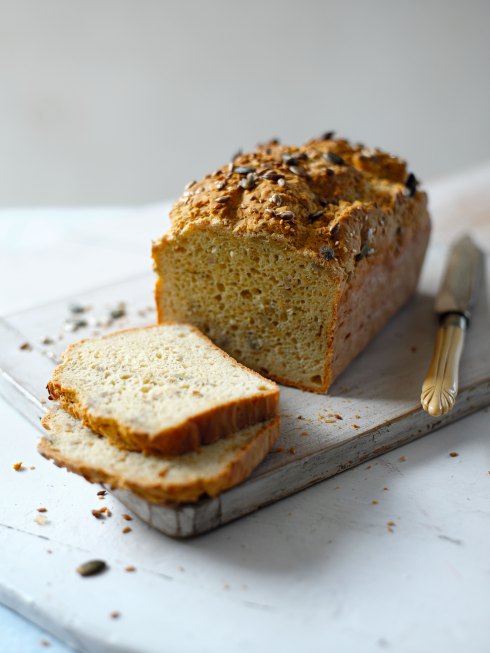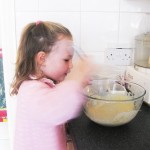Recently my publishers took some new photographs for the cover of the paperback version of Simply Gluten-Free & Dairy-Free. One of the recipes we tried was a bread recipe. I took the White Bread recipe that’s in the book and, in order to make it more visually punchy, added seeds to the recipe. This also adds crunchiness and an extra level of taste.
Adding seeds to bread is a brilliant way of introducing them into your daily diet. And, in doing so, you’re getting additional essential fatty acids, iron, zinc, B-vitamins, vitamin E, calcium and magnesium – helping you to enhance your immune system, combat energy and boost your brain power, amongst other things.
This bread really is delicious. It will keep well for a few days, and you can also freeze it. (I often cut it into slices, freeze it, and toast it straight from the freezer.) It didn’t make it to the cover shot, but it was lovely to eat at lunchtime on the shoot, anyway!
* gluten-free, dairy-free, egg-free, soya-free, nut-free, citrus-free
- 120g/4¼oz/⅔ cup potato flour (NB potato flour not potato starch)
- 50g/1¾oz/scant ½ cup gram flour
- 50g/1¾oz/⅓ cup maize flour
- 150g/5½oz/heaped ¾ cup brown rice flour
- 1 tsp sea salt, crushed
- 1 tsp fruit sugar or caster sugar
- 1 tsp gluten-free baking powder
- 1 tsp xanthan gum
- 1 tbsp dried active yeast
- 75g/2½oz mixed seeds – pumpkin, sesame, sunflower and linseeds, plus extra for sprinkling
- 2 tbsp olive oil, plus extra for greasing
- Preheat the oven to 200°C/400°F/gas 6 and lightly grease a 900g/2lb loaf tin with a little oil.
- Sift the flours, salt, sugar, gluten-free baking powder, xanthan gum, psyllium husks and yeast into a large mixing bowl and, using a metal whisk, mix thoroughly. Add the olive oil and mix in gently. Pour in 400ml/14fl oz/scant 1⅔ cups warm water and mix thoroughly with the whisk for at least a minute, to aerate the dough. Whisk until the dough holds some shape, but is still soft enough to fall from the whisk, adding 1 or 2 extra tablespoons of warm water if it feels too stiff. Add the mixed seeds and mix in gently. Alternatively, sift the flours, salt, sugar, gluten-free baking powder, xanthan gum, psyllium husks and yeast into the bowl of a food processor with the dough blade attached and blend to mix together. Add the olive oil and blend again, then add 400ml/14fl oz/scant 1⅔ cups warm water and process for 3–4 minutes to aerate the dough. It will be sticky. Remove the bowl of the food processor from the machine and mix the seeds into the dough mixture gently with a metal whisk.
- Spoon the dough into the tin. Dip a metal tablespoon in cold water and smooth the surface of the dough with the back of the spoon. Sprinkle some seeds over the top to cover.
- Bake for 55–60 minutes until the bread is golden brown. Turn out of the tin and tap the bottom. If it sounds hollow, it is done. If not, return the bread to the tin and bake for another 5 minutes, then test again to see whether it is done. Transfer to a wire rack to cool.







Your book has completely changed the way we eat – finally we can have pies and tarts again – thank you!
Just out of interest, do you have a background in nutrition as well as cookery? We have been given very little advice on what foods would help compensate for not eating enriched wheat products.
Hi Fiona, Lovely to hear from you and I’m delighted you like the book!
I’m not a nutritionist – I hope that I can show people the practical aspects of allergy diets, instead. Having said that, you’re right that it’s important to make sure you eat foods that will give you the nutrients wheat would have, if you’re going gluten-free. Whole wheat (NB I’m only talking about whole wheat here) is a great source of fibre (so make sure you’re taking in enough fibre, especially if you’re replacing wheat with white flours and starches. Also of B-vits and zinc. And wheatgerm is great in terms of vitamin E. If you look on this link, it’s got a good list of food sources for those vitamins. betterhealthchannel
All best,
Grace
hi ive made the bread but the mixer couldn’t mix it very well as it was very tough and dry, iadded bit more water but when I baked it it landed up like lead brick and stodgy in the middle, what did I do wrong
I am interested in trying this recipe because of the use of psyllium in place of eggs. But doesn’t it need to rise before baking? If so, for how long?
Hi Alicia, Lovely to hear from you. I don’t use eggs generally in my bread recipes as I don’t think you need to in terms of rise, and I don’t like the texture it gives the bread. I haven’t found any difference in terms of the rise of the bread if you leave it to prove or not. So I don’t. It’s all very quick and simple! Hope you enjoy it – do let me know. All best, Grace
Thank you, Grace, I shall start putting it together–how much psyllium should I use–it doesn’t say?, Alicia
Hi Alicia, You don’t need psyllium in this bread (I try not to use hard-to-get ingredients unless there’s a specific reason), but you can add it if you’d like. Probably 10g is best and reduce the brown rice flour to 140g. All best, Gx